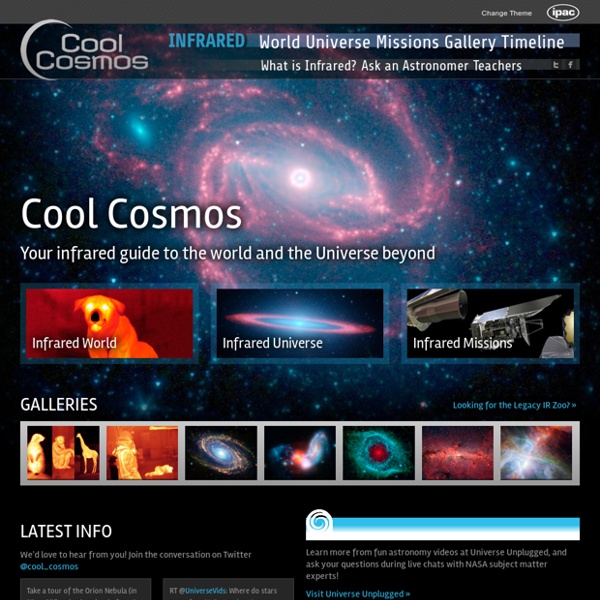



http://coolcosmos.ipac.caltech.edu/
Solar System, Solar System Information Our Cosmic Neighborhood From our small world we have gazed upon the cosmic ocean for thousands of years. Ancient astronomers observed points of light that appeared to move among the stars. They called these objects "planets," meaning wanderers, and named them after Roman deities—Jupiter, king of the gods; Mars, the god of war; Mercury, messenger of the gods; Venus, the goddes of love and beauty, and Saturn, father of Jupiter and god of agriculture. 2012 Skywatching Events Guide & 2012 Venus Transit This story was updated on Jan. 2. As the year 2011 comes to a close, some might wonder what is looming sky-wise for 2012? What celestial events might we look forward to seeing? I've selected what I consider to be the top 12 "skylights" for this coming year, and list them here in chronological order. Not all these events will be visible from any one locality … for the eclipses, for instance, you'll probably have to do some traveling … but many can be observed from the comfort of your backyard.
Star Map Note:You can't use fishing line. Don't even think about it. It just doesn't conduct light in the right way.[ref] You can buy optical fiber by the reel, but there are better and cheaper ways to get it*: For large star maps; a fake Christmas tree works very well! Space Shuttle Mission Games <center><div class="site_errors"><div class="floatType_site_error_top"></div><div class="floatType_site_error"><table summary="layout table"><tr><td bgcolor="#000000"><font color="#ffffff"><h2><img src="/templateimages/redesign/modules/overlay/site_error.gif" title="Site Error" alt="Site Error"/>There's a problem with your browser or settings. </h2></font><font color="#ffffff"><p>Your browser or your browser's settings are not supported. To get the best experience possible, please download a compatible browser. If you know your browser is up to date, you should check to ensure that javascript is enabled.
Monster Galaxy Cluster 'El Gordo' Packs Mass of 2 Quadrillion Suns AUSTIN, Texas — The largest cluster of galaxies seen yet in the early universe, a giant that astronomers have dubbed "El Gordo," could one day reveal secrets about the invisible dark matter that fills the universe, researchers said. El Gordo — which means "the fat one" in Spanish — is officially known as ACT-CL J0102-4915 and "is located more than 7 billion light-years from Earth, at a time when the universe was half its current age," study co-author John Patrick Hughes at Rutgers University told SPACE.com. The universe is about 13.7 billion years old. The monster galaxy cluster has mass about 2 quadrillion (that's 2 followed by 15 zeroes) times that of the sun, making it "the most massive known cluster in the distant universe." A galaxy cluster behemoth
how to use a telescope - how to use a telescope properly Let's talk about how to use a telescope properly. This is an important part of owning a telescope that many new telescope users overlook, or just don't think about. It's wonderful that you have taken an interest in Astronomy, and you're no doubt thinking of buying a telescope, or maybe you already have one. You already have an idea how telescopes work, but you have to know how to use a telescope too. The Cost of Exploring Space: Film vs. Reality Want to stay on top of all the space news? Follow @universetoday on Twitter We all know that space exploration, while certainly not the largest expenditure of most countries, doesn’t come cheap. But neither do big-budget science fiction films, either. Special effects, sets, special effects, popular acting talent… special effects… those all come with hefty price tags that make sci-fi and fantasy films costly ventures — although bigger definitely isn’t always better. If you were to compare the price of real space exploration missions (which provide actual information) to the costs of movies about space exploration (which provide “only” entertainment) what would you expect to find?
The Great Hubble This lesson plan may be used to address the academic standards listed below. These standards are drawn from Content Knowledge: A Compendium of Standards and Benchmarks for K-12 Education: 2nd Edition and have been provided courtesy of theMid-continent Research for Education and Learningin Aurora, Colorado. Grade level:6-8Subject area:scienceStandard: Understands the nature of scientific inquiry.Benchmarks: Understands the nature of scientific explanations (e.g., emphasis on evidence; use of logically consistent arguments; use of scientific principles, models, and theories; acceptance or displacement based on new scientific evidence). Astronomie - MESSENGER arrive aux abords de Mercure - AstroSurf Envoyé 03-01-2008 19:42 j'ai relevé ces precisions sur le site, où il s'avère que c'est bien pour diminuer la vitesse de la sonde afin qu'elle soit capturée par Mercure...Mais ça ne répond pas tout à fait à la question : pourquoi peut-on envoyer directement une sonde en orbite de Mars et pas de Mercure ? Rôle joué par le Soleil, faible masse de Mercure ?? "5. Why take such a long and complex route to Mercury?